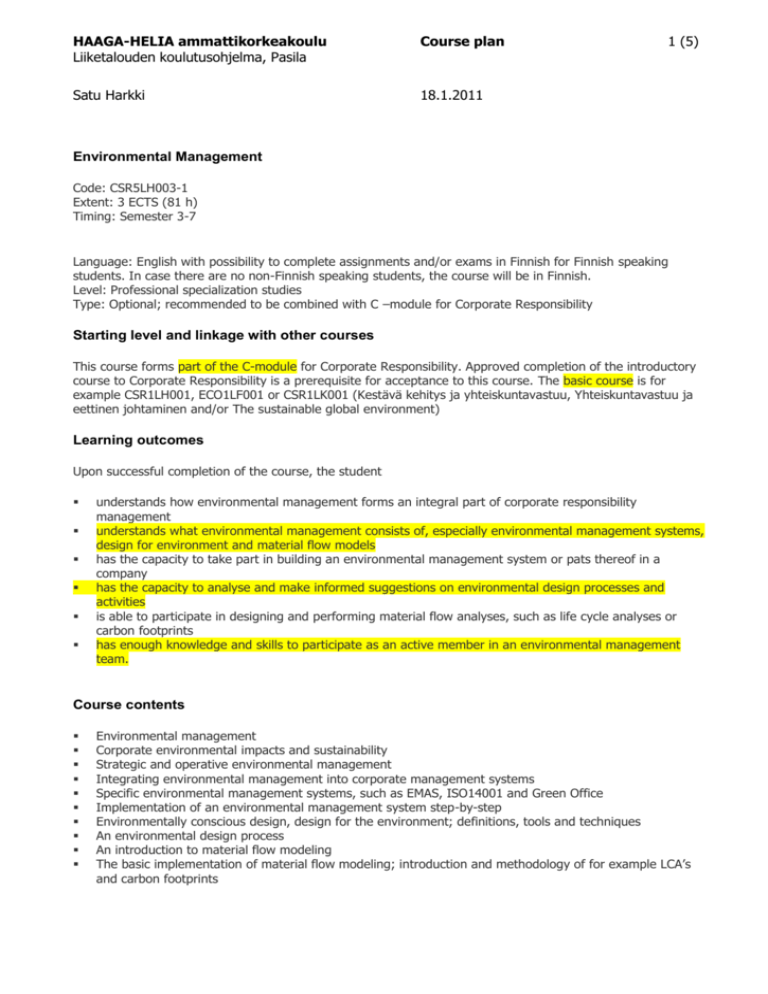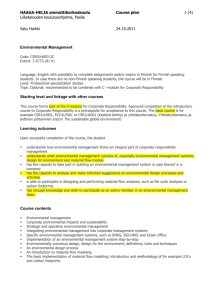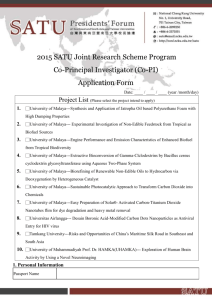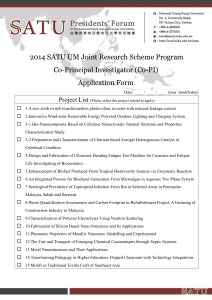Environmental Management - Haaga
advertisement

HAAGA-HELIA ammattikorkeakoulu Liiketalouden koulutusohjelma, Pasila Course plan Satu Harkki 18.1.2011 1 (5) Environmental Management Code: CSR5LH003-1 Extent: 3 ECTS (81 h) Timing: Semester 3-7 Language: English with possibility to complete assignments and/or exams in Finnish for Finnish speaking students. In case there are no non-Finnish speaking students, the course will be in Finnish. Level: Professional specialization studies Type: Optional; recommended to be combined with C –module for Corporate Responsibility Starting level and linkage with other courses This course forms part of the C-module for Corporate Responsibility. Approved completion of the introductory course to Corporate Responsibility is a prerequisite for acceptance to this course. The basic course is for example CSR1LH001, ECO1LF001 or CSR1LK001 (Kestävä kehitys ja yhteiskuntavastuu, Yhteiskuntavastuu ja eettinen johtaminen and/or The sustainable global environment) Learning outcomes Upon successful completion of the course, the student understands how environmental management forms an integral part of corporate responsibility management understands what environmental management consists of, especially environmental management systems, design for environment and material flow models has the capacity to take part in building an environmental management system or pats thereof in a company has the capacity to analyse and make informed suggestions on environmental design processes and activities is able to participate in designing and performing material flow analyses, such as life cycle analyses or carbon footprints has enough knowledge and skills to participate as an active member in an environmental management team. Course contents Environmental management Corporate environmental impacts and sustainability Strategic and operative environmental management Integrating environmental management into corporate management systems Specific environmental management systems, such as EMAS, ISO14001 and Green Office Implementation of an environmental management system step-by-step Environmentally conscious design, design for the environment; definitions, tools and techniques An environmental design process An introduction to material flow modeling The basic implementation of material flow modeling; introduction and methodology of for example LCA’s and carbon footprints HAAGA-HELIA ammattikorkeakoulu Liiketalouden koulutusohjelma, Pasila Course plan Satu Harkki 18.1.2011 2 (5) Cooperation with the business community The course is implemented in close cooperation with suitable companies through assignments and/or guest lectures or company visits. The corporate assignments can and will be combined with the other courses in the C-module whenever possible. Learning and teaching methods Contact hours: 28 hours Independent and group work: 53 hours The course employs research and development oriented learning. The students will prepare assignments either individually or in teams for the case company. The teacher will support in preparing the development work for the case company according to a determined schedule. Accreditation of prior learning (APL, in Finnish AHOT) Accreditation of prior learning is observed on the course according to separate instructions. HAAGA-HELIA ammattikorkeakoulu Liiketalouden koulutusohjelma, Pasila Course plan Satu Harkki 18.1.2011 3 (5) Lessons on Wednesdays at 12.15-15.30, classroom 2009, 8.2/15.2/29.2 also classroom 4004M. Date 18.1 25.1 h 4 4 Program Orientation Lecturer Satu Harkki Project work guidelines: Orion presentation at 13:15, create the groups Anne Allo/Orion Project work: Environmental stakeholders 1.Theme discussion Environmental management systems (ISO 14 001 and EMAS), implementation step by step Sirpa Pelttari/Orion Satu Harkki Lesson: Green Company Strategy and business environment 1.2 8.2 4 Project work: Business Environmental analysis, SWOT, Environmental strategy and policy No lesson, competitor analysis self-study 2. Theme discussion: Legal requirements, Corporate environment impacts, risks, targets and indicators, monitoring and corrective actions. Results of competitor analysis. Each student presents the main findings (max. 5 minutes/student). Bring also your analysis document to the contact lesson Lesson: GRI reporting for environmental issues, GRI G3 environmental materiality 15.2 4 Project work: Environmental impacts, GRI G3 environmental materiality, environment risks, objectives/targets and indicators 3. Theme discussion: Design for the Environment (DfE) and Lids Wheel, Material Flow Management and tools: LCA and Carbon Footprint Save your results to Moodle Satu Harkki Save your competitor analysis in Moodle discussion board before the lesson. Save your results in Moodle Satu Harkki Lesson: Green Innovations Project work: LCA, Lids Wheel for the Case, Carbon footprint 22.2 29.2 4 Winter holiday, no lesson 4. Theme discussion: Environmental friendly purchasing and partners, action plan/environmental program, implement the program/plan in the organization. Environment and Safety Management Cooperation on Save your results in Moodle Satu Harkki Kenneth Kumenius HAAGA-HELIA ammattikorkeakoulu Liiketalouden koulutusohjelma, Pasila Course plan Satu Harkki 18.1.2011 4 (5) Shoreline Oil Spill Response 7.3 4 Project work: Action plan/program Competitor analysis deadline. Return in Moodle. Kenneth Kumenius Satu Harkki Project work: Action plan/program 14.3 4 Project presentations + main findings of competitor analysis + discussion Satu Harkki Anne Allo/Orion Ideas for the thesis and projects for the Orion Course evaluation Sirpa Pelttari/Orion Theme discussions The course includes four theme discussions. Each student study individually the theme beforehand and makes notes with the sources and brings to notes to the contact-lesson. Based on the notes the students discuss the theme. The teacher evaluates the team discussions. Detailed instructions for the each theme are in the Moodle. Course tasks Learning Diary (self-study) Competitor analysis (self-study), separate instruction Project work (team work), separate instruction Learning Diary Each student writes a learning diary during the course. The learning diary should include each time: Memo of (1-2) theory themes and lessons depending what is the day´s content: 2. 3. 4. 5. 6. a. the theory of the themes (“direct copies are not allowed”) b. the professional lectures c. the teamwork session/presentations d. other What I have learnt? Why? Did something get badly? Why? How can you improve for the next time? Possible constructive feedback for the teacher Possible other thinking HAAGA-HELIA ammattikorkeakoulu Liiketalouden koulutusohjelma, Pasila Course plan Satu Harkki 18.1.2011 5 (5) Add each week your learning diary to the specific Moodle Discussion forum. Lecture/teamwork on Wednesday -> return learning diary memo at the latest next Sunday. If you can’t participate the lecture write the theme memos as guided and read all your fellows students´ diaries and write a summary of the diaries on the next Tuesday. Make also you own diary notes based on what you have read and learnt. Assessment criteria (1-5) for the learning diary are: Depth of the themes Depth of the reflection Assessment components and their respective weights Performance during contact lessons 20% Learning diary 20% Project work 30% Competitor analysis 30 % You must get grade 1 from each section. Performance during contact sessions. One 4 hour contact-lesson is 2 attendances. Grade Attendance (with high activity in theme discussion and activites) times 1 2 3 4 5 7 8 9-11 12-13 14 Contact Information Satu Harkki satu.harkki@haaga-helia.fi +358 404887064 Mailbox 50 Room 7015








